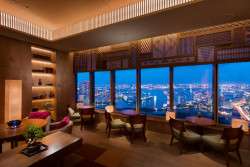
May 13, 2004
The Lost World
In search of an ancient civilization swallowed by the sea, Carlo Niederberger plunges into the waters off Yonaguni.
By Metropolis
Originally published on metropolis.co.jp on May 2004

Photos by Kihachiro Aratake and Carlo Niederberger
Yonaguni, at the frontier of the Okinawan archipelago, is in many ways a place of extremes. Japan’s westernmost island lies only 60 nautical miles east of Taiwan, and is home to an endemic variation of the Attacus Atlas Linnaues (“Ayamihabiru” in the native dialect), believed to be the world’s largest silkworm moth with a foot-long wingspan. The island also produces Japan’s strongest spirit, which, at 120 proof cannot be legally categorized as awamori (Okinawan shochu) and instead takes the name hanazake. The Yonaguniuma, grazing in herds on pastures overlooking the Pacific Ocean, is one of the smallest species of horses found in the country.
But the most extreme feature of all in Yonaguni is the site of submerged monuments discovered off the island’s southern coast in 1986. If scientifically proven to be a creation of man, the ruins would far outdate the Egyptian pyramids and point to a civilization that existed 10,000 years ago and then sank beneath the waves at the end of the last ice age-perhaps a remnant of the lost continent of Mu, the motherland of mankind.
Treasure trove
“I couldn’t believe my eyes. Looking down at the ruins that resembled the monuments of Machu Picchu, I was stupefied,” Kihachiro Aratake, 56, recalls animatedly over tea in his spacious living room, of the moment 18 years ago when he made the breathtaking discovery. Aratake, who also chairs the Yonaguni Tourism Association, has since guided many scholars and marine enthusiasts from the world over who have flown to this tiny island to see for themselves. But on whether an ancient civilization really existed there, the verdict is split.

Masaaki Kimura, marine geologist and professor at Okinawa’s University of the Ryukyus, is adamant the structures are artificial, and has conducted numerous dives on the archaeological site. Tokyo Governor Shintaro Ishihara, long known for his love of the seas, has also buddied with Aratake, a close friend of his, and emerged to joke that the 40cm-wide fissures found along one of the terraces were the remains of an aqueduct that drained the blood from a pre-historic execution site.
But on the flip side of the coin, there are experts who believe that the structures are merely rock formations scythed and smoothed by the powerful currents that run along Yonaguni’s shores. Robert Schoch, professor of geology at Boston University has told the BBC of his disappointment at finding the site to be primarily a naturally formed landscape, although he openly entertains claims that the monuments may have been terra-formed-or “modified” by human hands. On the other hand, it took only three dives for German geologist Wolf Wichmann to declare that he “didn’t find anything that was man-made.”
Such controversies have fueled the passion of Scottish journalist Graham Hancock, who has chronicled the Yonaguni disputes in Underworld: The Mysterious Origins of Civilization, in pursuit of the truth behind the enigmatic stone blocks. However, another man identified with by most divers may hold the keys to keeping the Yonaguni dream alive-the late Jacques Mayol, inspiration behind Luc Besson’s 1988 classic Le Grand Bleu.

“I immediately felt a special aura, some special vibration in the air, that something mysterious was here,” Mayol told TBS of his first visit to the island. Thereafter, the Shanghai-born free diver made numerous trips to Yonaguni, and over extended stays, nurtured an affinity for its seas as well as a brotherly fondness for Aratake. Mayol had been especially attached to a certain submerged rock shaped into a face similar to the monuments on Easter Island, and chose the site as his last dive spot in Japan before his death in 2001. Of the face, and the monuments of Yonaguni, the man who had bonded with the ocean like no other proclaimed, “the artistic touch of mankind had been (applied) here.”
Close encounters
With legends both new and old swirling in my mind, we plunged into the warm, crystal-clear water and made a hurried descent, flanking the 290-meter-long and 150m-wide structure lying in 30m of water at its deepest point. The tour of what Kimura maintains is an ancient temple began by slipping through under a narrow arch, where two oblong rocks loom ahead, eerily resembling the Twin Towers of the World Trade Center. We kicked along due south to the “main terrace” lying around the corner, and above the grotesquely flat area in the shadows of perfectly perpendicular walls, an upper terrace came into view adjacent to giant steps that emerge from “loop roads” deeper down.
Now only a few meters below the surface, we glanced upward at the underside of waves tumbling against the protrusions above sea level. Further east, we encountered the “triangular pool,” a structure that appeared to have been a depression containing water with stepping stones leading in and out, and eventually the peculiar “sea turtle” monument with an immaculately carved “headpiece” sprouting from its shell at a 45-degree angle. Amid this convoluted site of horizontal, vertical and diagonal engineering sat an immense rock called the “spiritual stone” inside a smooth, oval-shaped chamber. A juvenile sea turtle hovered there like a living icon of the past.
Beyond Yonaguni’s coral reefs and towering cliffs lie pastures where horses and bovines graze in a silence and solitude like no other found across Japan. A tropical forest where unseen species of mammals and insects proliferate covers more than half the island. Rice fields occupy what little flatland there is on the fringes of the three hamlets that make up the bulk of the island’s population of 1,852. To the islanders, and to the few who travel this far, life revolves around the sea.
July is the month of the annual swordfish tournament, where fishermen gather to fish for marlin, Yonaguni’s staple catch. In late January, schools of hammerhead sharks, some in the hundreds, arrive at the southwestern tip of the island to ride the powerful Kuroshio Current. And not far from where the sleek predators roam the depths to the delight of divers, on a huge, submerged stone slab near the statue of the face, lies a titanium plaque dedicated to the memory of Jacques Mayol, the embodiment of mankind’s love for the ocean.
Getting there
Japan TransOcean Air and Ryukyu Air Commuter (www.jal.co.jp/jta) run scheduled flights linking Yonaguni with Ishigaki and Naha, respectively. (Both Japan Airlines/JTA (www.jal.co.jp) and All Nippon Airways (www.ana.co.jp) offer nonstop flights from Haneda to Naha or Ishigaki) A ferry also makes two trips per week from Ishigaki and takes approximately four hours.
Where to stay
Hotel Irifune is located in the township of Sonai, and offers fully furnished Western as well as Japanese-style rooms. For details, see www.yonaguni.jp/hotel.htm (Japanese only).
More information
SAWES Yonaguni, owned by Aratake, operates several fully equipped boats and a conveniently located, sizable dive shop. All dives at Yonaguni are drift dives, and depending on currents, may be challenging for novice divers. Prior certification and reasonable experience are recommended. www.yonaguni.jp/sawes.htm
[geo_mashup_map]







